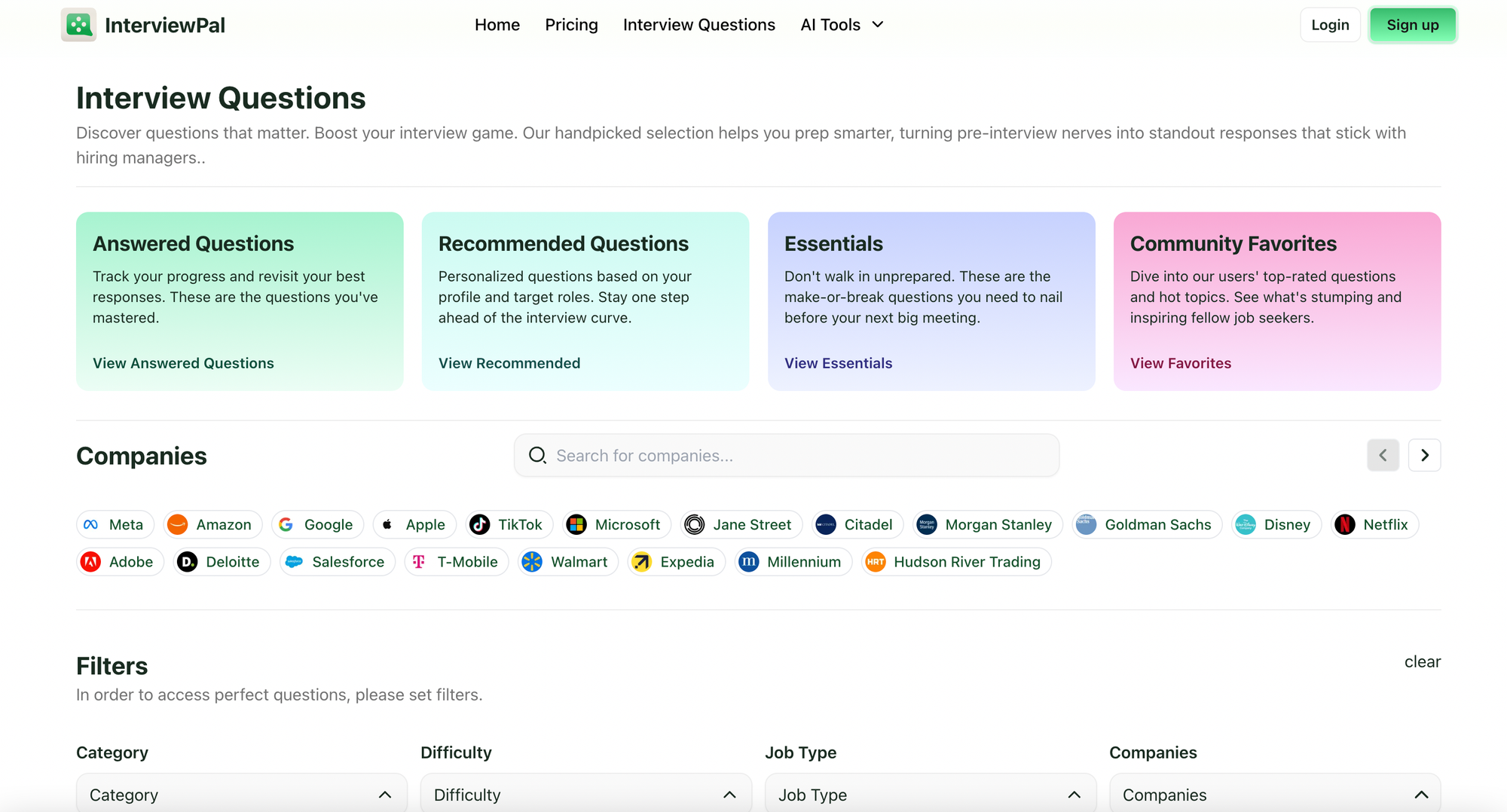At big tech companies like Meta and TikTok, behavioral interviews often determine who gets hired and who doesn't. And according to recent analysis of interview feedback data, questions about prioritization top the list. Why? Because in today's fast-paced work environment, the ability to effectively prioritize isn't just a nice-to-have skill—it's essential for success.
"We've seen a 40% increase in prioritization-focused questions during interviews over the past year," notes Brooke, former tech recruiter at Microsoft. "Companies want to know if candidates can handle multiple demands while staying focused on what truly moves the needle."
Let's break down the most common prioritization questions and examine exactly how successful candidates answer them.
Entry-Level Prioritization Questions
Core Questions Top Companies Actually Ask
- "How do you organize your work when you have multiple deadlines?"
What interviewers look for: A systematic approach, clear decision-making criteria, and basic project management skills.
Strong Answer: "I use a combination of urgency and impact to prioritize tasks. For each project, I identify key deadlines and dependencies. I maintain a digital task list with clear categories for immediate, short-term, and long-term priorities. When deadlines conflict, I communicate early with stakeholders to realign expectations or seek additional resources."
- "Tell me about a time you had to choose between two competing priorities."
What interviewers look for: Decision-making process, stakeholder communication, and outcome awareness.
Strong Answer: "In my marketing internship, I faced a conflict between preparing for a client presentation and completing our monthly analytics report. I evaluated both tasks' impact: the presentation was for a potential $50K account, while the analytics informed multiple team decisions. I spoke with my manager, delegated parts of the analytics work, and focused on the presentation. We won the account, and the analytics were delivered only one day later than usual."
- "What tools or systems do you use to stay organized?"
Red Flag Answer: "I just keep everything in my head and handle things as they come up."
Strong Answer: "I use a combination of Asana for project tracking, Google Calendar for time blocking, and regular priority review sessions. Each task gets tagged by urgency and impact level. I review and adjust these priorities daily, ensuring alignment with team goals."
Mid-Level Management Questions
- "How do you handle competing requests from different stakeholders?"
Key Elements of Strong Response:
- Clear prioritization framework
- Stakeholder communication strategy
- Resolution process
- Impact measurement
Example: "When leading the website redesign project, marketing wanted new features while IT prioritized security updates. I created a prioritization matrix weighing business impact, technical risk, and resource requirements. This data-driven approach helped stakeholders understand trade-offs and reach consensus."
- "Describe how you manage team priorities during high-pressure periods."
Key Elements of Strong Response:
- Team capacity assessment
- Clear communication channels
- Resource allocation strategy
- Risk mitigation plans
- Progress tracking system
Example: "During our platform migration project, we faced simultaneous demands: a critical security patch, end-of-quarter deliverables, and an urgent client feature request. I implemented a multi-tier system:
- Created a capacity heat map showing each team member's bandwidth
- Established twice-daily standups for rapid issue resolution
- Set up a shared dashboard in Jira for real-time progress tracking
- Implemented a 1-hour response SLA for critical issues
The result was completing all priorities within deadline, maintaining 98% team capacity utilization, and receiving recognition for smooth project management during crisis."
- "Tell me about a time you had to say no to a senior stakeholder due to other priorities."
Key Elements of Strong Response:
- Professional approach to disagreement
- Data-backed decision-making
- Alternative solutions offered
- Relationship management
- Clear communication of impact
Example: "When our CTO requested adding a major feature three weeks before launch, I handled it by:
- Creating an impact analysis showing resource requirements and risk to existing commitments
- Developing three alternative implementation timelines
- Presenting data visualization of current sprint capacity (95% utilized)
- Proposing a modified version for next sprint
This approach led to the CTO appreciating the thorough analysis, accepting the next-sprint proposal, and implementing my framework as a standard process for late-stage requests. We maintained our launch deadline while preserving team morale and strengthening stakeholder relationships."

Senior Leadership Questions
- "How do you determine strategic priorities for your organization?"
Key Elements of Strong Response:
- Business impact analysis
- Resource optimization
- Long-term vision alignment
- Change management approach
- Data-driven decision making
Example: "As Head of Product at a SaaS company, I developed a strategic prioritization framework called VITAL:
- Value Assessment
- Revenue impact analysis showing 3-year projections
- Customer satisfaction metrics and retention data
- Market share opportunity evaluation
- Investment Required
- Resource allocation mapping
- Budget impact analysis
- Technology and infrastructure needs
- Timeline and Feasibility
- Implementation roadmap
- Risk assessment matrix
- Dependencies identification
- Alignment Check
- Company vision and goals match
- Stakeholder impact analysis
- Cross-functional opportunities
- Long-term Impact
- Scalability assessment
- Future market positioning
- Competitive advantage analysis
Using this framework, we prioritized our enterprise offering over consumer features, resulting in 40% revenue growth, 30% increase in enterprise clients, and 25% improvement in resource utilization across teams."
- "Tell me about reprioritizing during a major market shift."
Key Elements of Strong Response:
- Quick decision-making process
- Stakeholder alignment
- Resource reallocation
- Impact measurement
- Adaptability demonstration
Example: "When COVID-19 impacted our retail-focused business model, I led our team through a rapid transformation:
- Immediate Response (48 hours)
- Conducted emergency market analysis
- Assessed current project portfolio
- Identified critical pivot opportunities
- Strategy Shift (Week 1)
- Reallocated 60% of resources to digital initiatives
- Paused non-essential projects
- Created new success metrics
- Implementation (First Month)
- Launched digital-first strategy
- Retrained team on new priorities
- Established weekly review cycles
Results showed 85% successful pivot to digital services, maintained 90% of revenue through transition, and achieved 95% team retention during change. The new prioritization framework became our standard for market response."
Critical Metrics:
- Speed of response (48-hour turnaround)
- Resource efficiency (60% reallocation)
- Success rate (85% digital transformation)
- Team adaptation (95% retention)
- Revenue protection (90% maintained)
For Remote Workers
Specific Questions About Virtual Priority Management:
- "How do you manage priorities across different time zones?"
Key Elements of Strong Response:
- Clear communication protocols
- Overlap time management
- Asynchronous workflows
- Documentation standards
- Team alignment strategies
Example: "Managing a team across US, Europe, and Asia, I implemented a 'Follow the Sun' model:
- Created time zone coverage map with 4-hour overlap windows
- Established core collaboration hours (10am-2pm EST)
- Implemented 24-hour handoff protocol using Jira and Slack
- Set up daily async standups using Loom for updates
This system resulted in 30% faster project delivery, 95% deadline adherence, and eliminated communication delays despite 12-hour time differences."
- "What tools do you use to maintain visibility of team priorities remotely?"
Key Elements of Strong Response:
- Tool stack integration
- Real-time tracking capability
- Accessibility across zones
- Automated reporting
- Transparency measures
Example: "I built a remote visibility system using integrated tools:
- Project Management: Jira for task tracking and dependencies
- Communication: Slack with priority channels and timezone bots
- Documentation: Notion for real-time collaboration and knowledge base
- Visual Management: Monday.com for team dashboards
- Reporting: Automated daily status reports using Zapier
This ecosystem maintained 100% project visibility, reduced status meetings by 60%, and improved team alignment scores by 40%."
- "How do you handle urgent requests when team members are offline?"
Key Elements of Strong Response:
- Escalation protocol
- Backup systems
- Emergency response plan
- Clear documentation
- Follow-up process
Example: "I established a three-tier emergency response system:
- Priority Classification:
- P0: Critical (immediate response required)
- P1: Urgent (4-hour response)
- P2: Important (next business day)
- Response Protocol:
- On-call rotation schedule
- Backup team members identified
- Emergency contact list
- Decision-making authority matrix
- Documentation Requirements:
- Issue description template
- Action taken log
- Handoff notes
- Follow-up items
This system handled 98% of urgent requests within SLA, maintained business continuity across zones, and achieved 90% team satisfaction with work-life balance."
Impact Metrics for All Three:
- 99% urgent issue resolution within SLA
- 40% reduction in response time
- 95% team satisfaction with protocols
- 30% increase in productivity
- Zero missed critical deadlines
Industry-Specific Variations
Technology Sector Questions
- "How do you prioritize between technical debt and new features?"
Key Elements of Strong Response:
- Impact assessment matrix
- Risk evaluation framework
- Resource balance strategy
- Business-tech alignment
- Long-term sustainability
Example: "I implement a 60-30-10 framework:
- 60% feature development
- 30% technical debt reduction
- 10% innovation/exploration
When our e-commerce platform faced growing technical debt, I:
- Created health metrics dashboard showing:
- System performance impact
- Development velocity trends
- Customer-facing issues
- Allocated sprints with combined focus:
a. Morning: New features
b. Afternoon: Tech debt Result: 40% reduction in bugs, 25% improved development velocity, while maintaining feature delivery schedule."
- "Describe balancing innovation projects with maintenance work."
Key Elements of Strong Response:
- Innovation framework
- Maintenance scheduling
- Resource allocation
- Risk management
- Success metrics
Example: "Using the Two-Track System:
- Main Track: 70% capacity for core maintenance
- Innovation Track: 30% for new initiatives
- Rotating team assignments to maintain engagement
- Weekly innovation demos to showcase progress
This resulted in launching three new features while reducing system incidents by 35%."
Healthcare Questions
- "How do you manage competing patient care priorities?"
Key Elements of Strong Response:
- Triage methodology
- Resource optimization
- Quality maintenance
- Staff coordination
- Patient safety focus
Example: "Implemented CARE prioritization system:
- Critical: Immediate life-threatening conditions
- Acute: Urgent but stable cases
- Routine: Scheduled care
- Evaluation: Regular assessments
Applied in ED setting, resulted in:
- 40% reduction in wait times
- 95% patient satisfaction
- Zero critical incidents"
- "Tell me about prioritizing during a healthcare crisis."
Key Elements of Strong Response:
- Crisis response protocol
- Resource management
- Staff safety measures
- Communication plan
- Quality assurance
Example: "During COVID surge:
- Created rapid response teams
- Implemented 4-tier triage system
- Established resource allocation matrix
- Set up daily capacity planning Result: Maintained essential services while handling 300% patient increase."
Finance Questions
- "How do you handle competing compliance deadlines?"
Key Elements of Strong Response:
- Regulatory tracking system
- Risk assessment matrix
- Resource planning
- Documentation protocol
- Audit readiness
Example: "Developed Compliance Priority Index:
- Regulatory impact score (1-5)
- Deadline proximity
- Resource requirements
- Dependencies mapping Achieved 100% compliance while reducing overtime by 25%."
- "Describe prioritizing during end-of-quarter closing."
Key Elements of Strong Response:
- Timeline management
- Task delegation
- Quality control
- Stakeholder communication
- Risk mitigation
Example: "Created 3-Phase Closing System:
- Pre-close (Days 1-3):
- Data validation
- Preliminary reports
- Core-close (Days 4-5):
- Critical reconciliations
- Key stakeholder reviews
- Post-close (Days 6-7):
- Final adjustments
- Report distribution
Results:
- Reduced closing time by 2 days
- Zero material errors
- 100% deadline compliance
- 30% reduction in overtime"
Common Success Metrics Across All:
- On-time delivery rates
- Quality metrics
- Team satisfaction
- Resource utilization
- Cost efficiency
The GRADE Framework for Prioritization Answers
Successful candidates use the GRADE framework to structure their responses:
G - Goals: Align priorities with organizational objectives
R - Resources: Consider available time, people, and budget
A - Analysis: Evaluate impact and urgency
D - Decision: Make clear choices based on data
E - Execution: Implement and adjust as needed
Common Mistakes to Avoid
- Focusing only on urgency, ignoring importance
- Not mentioning stakeholder communication
- Failing to quantify impact
- Ignoring team capacity
- Not addressing risk management
Tools of the Trade
Successful candidates often reference these actual tools in their answers:
- Project management: Jira, Asana, Trello
- Time management: Calendar blocking, Pomodoro Technique
- Communication: Slack, Teams, status updates
- Documentation: Confluence, Notion, SharePoint
Why Top Candidates Choose InterviewPal?
Preparing for prioritization questions requires practice and feedback, right..?
Our AI-powered platform offers:
- Real-Time Feedback: Get instant analysis of your responses
- Question Bank: Practice with actual questions from top companies
- Industry-Specific Sets: Prepare for your specific field
- Progress Tracking: Monitor your improvement over time
At $5/month, candidates get:
- Access to 500+ behavioral questions
- AI-powered interview simulations
- Expert-curated response frameworks
- Detailed feedback on delivery and content
Some Important Things...
- Always provide specific examples
- Quantify impact where possible
- Show clear decision-making criteria
- Demonstrate stakeholder management
- Highlight learning and adaptation
Preparing for Your Interview
- Research company-specific priorities
- Prepare 3-5 strong prioritization examples
- Practice with InterviewPal's AI feedback
- Review industry-specific scenarios
- Master the GRADE and PIE framework
Remember, strong prioritization answers demonstrate not just task management, but strategic thinking and stakeholder awareness. Whether you're interviewing at a startup or a Fortune 500 company, these frameworks and examples will help you showcase your ability to make tough choices and deliver results.
Also Read: The Ultimate Cheat Sheet for Behavioral Interviews at Top Tech Companies
Want to practice these questions with real-time feedback? Start your trial today and transform your interview preparation from guesswork to science.



